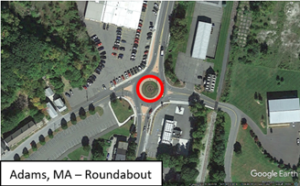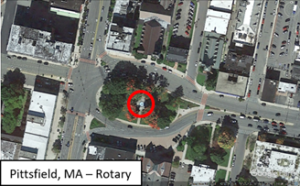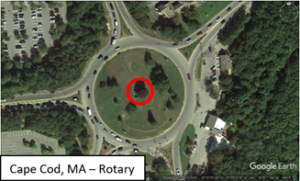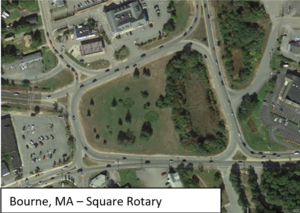Modern Roundabouts in the Berkshires
In October 2021, the City of Pittsfield’s first-ever modern urban roundabout became operational at Tyler Street and Woodlawn Ave. The only other modern roundabout currently in the Berkshires is in Adams, constructed in 2016 on Route 8 by the Massachusetts Department of Transportation. Pittsfield’s roundabout is built entirely on city-owned roads in one of the densest neighborhoods of the city: no small feat.
The most important characteristic of a modern roundabout is its safety improvement at “uncontrolled” intersections (ones without a traffic light). Many traffic studies point out the reductions in delay and improvements of traffic flow and safety. This article reviews the psychology that plays into these benefits. Why is it safer? How does the roundabout’s design improve how you operate in the driver’s seat? (Or with your feet or handlebars?)
Roundabouts are self-regulating. All travelers entering the intersection follow the same order of operations, regardless of which street one is moving on. This greatly increases predictability and uniformity. Stop signs and traffic lights require reaction times and judgment calls from drivers about whether it is safe to proceed, as well as predictions and assumptions about what a driver in front of them or across from them might do (will they beat the yellow light? Will they pull out in front of me?). At a roundabout, the right-of-way is not “given” or “taken;” rather, it is used equally by all entering the intersection since all directions must yield to traffic already in the circle.
Roundabouts keep things simpler. When turning left from a side street, we must consider two directions of traffic: the one coming from the left and the right. We then run a mental calculation on whether a gap is large enough to enter, considering the speeds of oncoming cars, our own vehicle’s acceleration power, the distance of the intersection to cover, and an assumption about whether the oncoming drivers will see us. With a roundabout, one only needs to look to their left and wait for a gap as traffic moves counterclockwise around the circle. Stopping for pedestrians happens separately before considering the traffic in the intersection. This procedure is identical when one is turning right or continuing “straight” through the roundabout. Sight lines are never blocked by plants or buildings. Speeds are low, so acceptable gaps can be smaller. If a collision occurs in the roundabout, it will almost certainly be a low-speed “angle” collision rather than a 90-degree or head-on crash, which greatly reduces the chances of a fatality or trauma.

Roundabouts are not rotaries. New England is known for (or notorious for) its sprawling circular intersections, often called rotaries or traffic circles. Think of Park Square in Pittsfield or the oval-shaped rotary in Williamstown. It is important to distinguish these from modern roundabouts to reduce confusion. Building new rotaries is not allowed. While rotaries may have made good junctions in the era of buggies and streetcars, nowadays, they present a dangerous cocktail of higher speeds through the circle and the need to merge and weave with traffic entering and exiting. Often, this is either at sharper angles than modern roundabouts have or at nearly tangential angles to the circle, allowing entry at high speed.
What distinguishes roundabouts from rotaries?
- Rotaries can include traffic control: either stop signs or traffic signals.
- Rotaries are often roads in their own right, rather than “intersections.”
- There can be multiple lanes or even driveways exiting onto rotaries.
- Allowed speeds in rotaries often top 30 mph, while most modern roundabouts allow for 15-25 mph speeds by design.
- Modern roundabouts are more compact, with footprints of anywhere from 100-200 feet across, while traditional rotaries can be up to three times larger in some cases. See the included photos for comparisons of scale.
The first modern roundabout in North America was built only thirty-one years ago, in 1990. The concept was imported from Europe about thirty years after it was tested and standardized there. Like any new technology, adoption takes time and practice. And while construction is always disruptive, the improvements to safety, operations, and traffic flow will prove worth the time and cost. Will Pittsfield be the next Carmel, Indiana? Probably not. But expect to see more roundabouts appear as modern solutions to historically challenging intersections.

